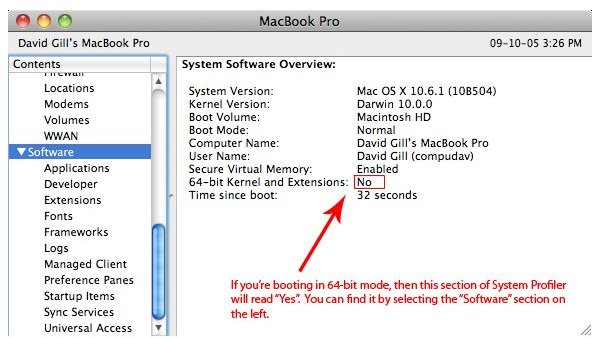Easily Boot Snow Leopard in 64-bit Mode
The 64-bit Dilemma
Ever since the release of the first 64-bit processors approximately eight years ago, the technology industry has struggled with a very rocky road trying to transition the world from the old, but very prevalent, 32-bit architecture to the newer 64-bit CPUs. The benefits of the higher bits are astounding, especially when it comes to accessible RAM. Older processors found in many computers could only access up to 4 GB of RAM (without really awkward kernel level hacks), however, newer 64-bit CPUs can make use of whopping 17.2 billion gigabytes of memory.
Snow Leopard was advertised as being partially rewritten to provide full support for 64-bit processors. As such, many people were surprised when they installed Mac OS X only to find that the kernel (the heart of the operating system) wasn’t running in 64 bits. This was a design decision by Apple’s engineers. One of the biggest issues with the transition is that all your old 32-bit extensions cannot work in 64-bit mode so if you have a lot of peripherals for which you’ve downloaded drivers and the like, then this trick certainly isn’t for you. It’s also worth noting that all of your 64-bit applications, like Safari, will still run in their native 64-bit mode even without the 64-bit kernel.
For those who still wish to proceed with the trick, before we illustrate how to boot in full 64-bit mode, please make sure that you’ve backed up your data and contents. While this trick shouldn’t cause any permanent issues, if you elect to make this change permanently and either have or add an old extension, you will likely experience a kernel panic when booting. As such, in this case, it’s definitely better to be safe than sorry.
Booting in Full 64-bit Mode
If you’ve decided that you’d like to experience Snow Leopard in all its 64-bit glory, then there are two ways of doing so. One method only boots into 32 or 64-bit mode once, while the other is intended to permanently boot into one mode or another.
Boot Into 32 or 64-bit Mode Once
To boot into one of these modes once, hold down their respective keys during your Mac’s start-up. So, to boot into 64-bit mode, simply hold down the “6” and “4” keys while your Mac is booting. This will tell the computer to use that kernel version. Conversely, should you wish to try 32-bit mode, you can hold down the “3” and “2” keys while booting. Holding down these keys will only make your Mac boot into its respective mode for that particular instance. Upon restart, OS X will boot into whichever kernel version it had been using.
Boot Into One Mode Permanently
If you’ve tried the above method and you’d found that there are no problems and you’d like to boot in that mode permanently, you can do so by following these steps. First, go to Applications -> Utilities -> Terminal. Type in “sudo pico /Library/Preferences/SystemConfiguration/com.apple.Boot.plist” (minus the quotation marks). Then you should see a section like this:
What we want to change is the “
Finally, once you’ve made the changes, simply press Ctrl-X, type in Y to save the modified buffer, and press enter. Voila! You’re now booting using the 64-bit kernel permanently!
Final Thoughts
Remember that changing this kernel will not really affect the speed or functionality for the average user. If you’re a developer or you have a 64-bit only kernel extension, then it might be quite useful to switch modes. However, for anyone but the power user, it generally ill-advised to boot into 64-bit mode.
If you try this trick and find that you’re getting kernel panics, make sure to hold down the keys of your prior mode while booting your Mac. This will allow you to get back into the system and edit the com.apple.Boot.plist file.
All in all, this is a cool trick and after you change your plist file, you can finally say that you’re running in full 64-bit mode!
